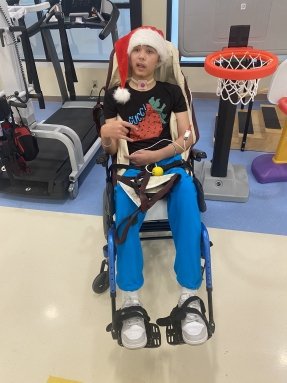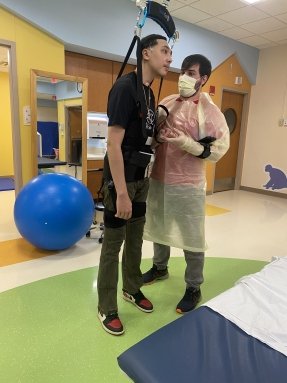Coming Back from the Edge: Terrell's Subway Surfing Recovery Journey

In June 2022, 15-year-old Terrell was out with friends when he climbed on top of a subway train. While surfing, he was struck in the head by an overhead beam as the train was pulling into a subway station. He was rushed to Elmhurst Hospital in Queens with a severe traumatic brain injury.
Following numerous complex surgeries, Terrell was admitted to Blythedale Children’s Hospital for comprehensive rehabilitation to facilitate his recovery. In addition to his brain injury, Terrell sustained a vision impairment known as strabismus that caused a misalignment of his eyes, making it difficult to coordinate his hand and eye movements.
Upon his admission to Blythedale, Terrell was in a deep state of disorder of consciousness. He was unable to talk, walk, or eat independently.

“It was really hard to know what to expect when Terrell first got here,” said Dr. William Watson, Blythedale's director of Child Psychology and a member of Terrell's interdisciplinary care team. “He was not able to consistently respond to the commands that we were giving him, he wasn’t able to communicate, he wasn’t able to demonstrate that he understood the language we were giving him.”
Terrell had extensive damage to his brain on both the right and left sides, affecting his ability to move both sides of his body. Although the right side of his body was less affected, Terrell’s occupational therapist, Lisa Tulevski, OTR/L, began working on his fine motor movements to improve his hand-eye coordination and left-sided hemiplegia.
After the cranioplasty to rebuild his skull had taken place and Terrell had begun to heal, he was met with another obstacle: hydrocephalus.
Dr. Watson explained that when the brain swells it can be common for fluid to build up and put pressure on the brain. That pressure, he noted can cause additional injury to the brain, which led to a setback in Terrell's case.

“Once Terrell was able to get over that hump, he really started to be able to stand up on his own,” said George Corbiere III, PT, DPT. “He started to be able to take steps on his own, without me having to move his leg.”
Terrell’s team also worked together to help him learn how to use a power wheelchair. As Terrell could not walk long distances, power mobility would allow him more ability to access his environment.
“When he first came to Blythedale, it was really hard to tell if Terrell was going to walk again because everything was so hard for him and everything was affected,” said Tulevski. “George was working on walking, and I was working on the power chair. And we always used to say, 'It is a race to see which one he gets first', because he was making such rapid progress in all areas. We were trying to get him as independent as possible as quickly as we could.”
Ultimately, Terrell began walking on his own, no longer needing the power wheelchair. “At first it was baby steps,” said Corbiere. Today, Terrell is navigating uneven terrain, including stepping off curbs and navigating other obstacles in his community.
To help Terrell speak again, Senior Speech Pathologist Stephanie Devlin, MS, CCC-SLP, TSSLD-BE, worked with Terrell on various breathing exercises to build his strength and stamina.
“He was not strong enough and did not have the coordination yet to produce his voice," she said. "We would work a lot on techniques to try to strengthen his breathing muscles to be able to push his voice out.”
Terrell worked extremely hard every day throughout all his therapy sessions to bring all those skills to where he is today, walking, talking, and able to move his left side.
In December 2023, Terrell was discharged from Blythedale’s Inpatient Hospital and was admitted to the Robert Stone Day Hospital at Blythedale, where he also attends 11th grade at the on-site Mount Pleasant Blythedale School.

Terrell continues to refine his walking and ability to use his left side. In Speech, he works on higher level cognitive linguistic skills, as well as executive functioning, including decision-making, problem-solving, social awareness, and self-advocacy.
Terrell has also begun to use his voice to encourage patients and families at Blythedale, letting them know he was where they are now and sharing how much progress he has made. Terrell also hopes to use his journey to spread awareness about the dangers of subway surfing.
“To be able to turn this around and use his voice to encourage others to not have to go through what he did, I think really speaks to his character,” said Devlin.
Terrell’s goal now is to encourage others to think twice before subway surfing.
“The quote goes, ‘high risk, high reward’,” said Terrell. “You are offering the highest risk, your life, for little reward. It’s not worth it.”



